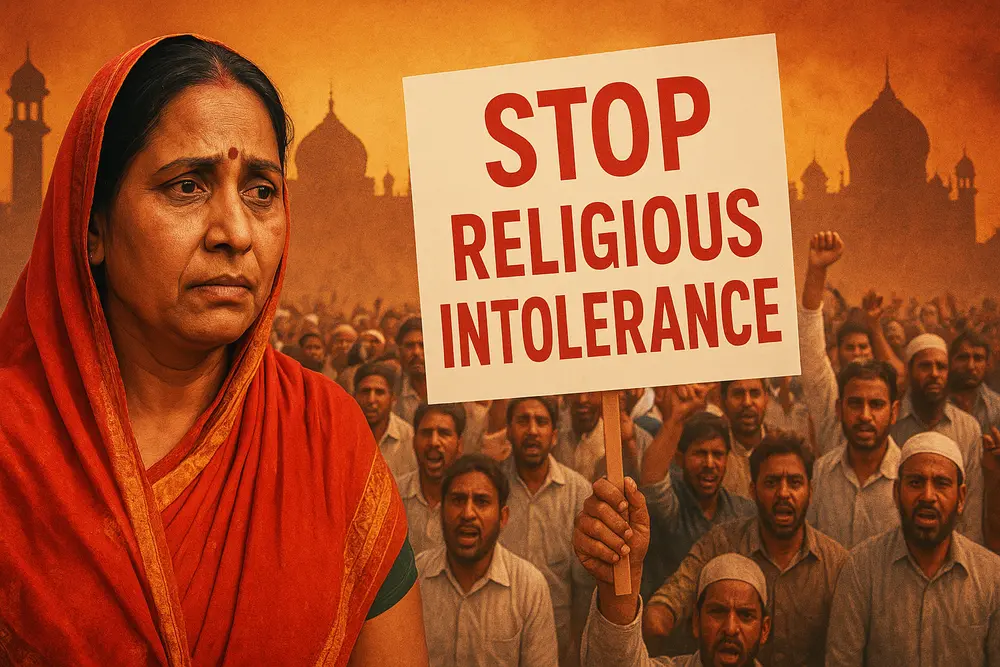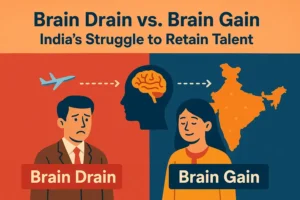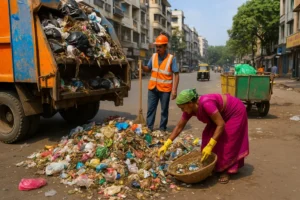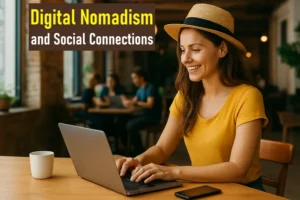Imagine living in a country where temples, mosques, churches, and gurudwaras stand side by side, and festivals of all faiths light up the streets with colors, music, and joy. That’s the spirit of India—diverse yet united. But in 2025, this harmony faces serious challenges.
Rising religious intolerance is quietly shaking the trust that holds communities together. Small disputes over food, festivals, or processions often turn into big conflicts.
Hate speech spreads faster than facts, and fear replaces friendship. When people stop seeing each other as neighbors and start seeing only religion, peace begins to crack.
So, how does religious intolerance affect India’s social fabric? Let’s explore the deep ways it touches daily life, politics, economy, and culture.

How Does Religious Intolerance Impact Social Harmony in India in 2025? Introduction
India’s social fabric is famously diverse—woven from dozens of faiths, hundreds of languages, and countless local cultures.
Social harmony, then, is not an abstract ideal; it is the everyday skill of living together across difference. In 2025, however, that skill is being stress-tested.
“Religious intolerance” refers to attitudes, policies, and behaviors that demean, exclude, or harm people because of their faith or belief (including disbelief). It can be overt (violence, hate speech, vandalism of places of worship) or systemic (laws and practices that disproportionately burden specific communities).
The consequences are wide: mistrust among neighbors, polarized politics, disrupted markets, fearful classrooms, and strained institutions. These patterns are documented by international and domestic observers.
Rising religious intolerance in India threatens national integration by deepening divisions, marginalizing minorities, and undermining constitutional values of secularism and unity.
Human Rights Watch notes that the first citizenship certificates under the Citizenship Amendment Act (CAA) were granted in 2024, while the law explicitly excludes Muslim refugees—intensifying perceptions of unequal belonging.
Freedom House’s 2025 country report also describes discriminatory policies and a climate less welcoming to religious minorities.
Meanwhile, the U.S. Commission on International Religious Freedom – USCIRF recommended in 2025 that India be designated a “Country of Particular Concern,” citing anti-conversion and cow-slaughter laws enforced in ways that impact Muslims and Christians.
These findings sketch a landscape where intolerance can ripple into everyday life.
While many Indians value tolerance, survey research also shows strong preferences for marrying within one’s religion and for living socially separate lives—habits that, in tense moments, can harden into suspicion.
This tension between ideals of tolerance and patterns of segregation is crucial to understanding how intolerance undermines harmony: it deepens existing boundaries, normalizes discrimination, and makes reconciliation harder when conflict occurs.
Everyday Trust Erodes When Segregation Hardens
Social harmony depends on everyday trust—borrowing a cup of sugar, car-pooling to work, or letting kids play together. When intolerance rises, that casual trust shrinks.
Housing societies may quietly avoid renting to people from certain faiths. Parents may hesitate to let children attend a friend’s festival. Markets in mixed neighborhoods can see footfall drop after a rumor spreads online.
Research by the Pew Research Center shows a strong preference across groups for marrying within one’s religion and for social lives organized along religious lines.
By itself, endogamy is not intolerance. But when public narratives cast neighbors as suspect, these preferences can harden into social distance, and social distance can convert fear into “common sense.”
In such climates, a loudspeaker dispute, a procession route, or a local meat ban can quickly become communal flashpoints, because the preexisting trust that usually defuses small frictions is missing.
Over time, neighborhoods that once hosted shared celebrations become zones of avoidance, and harmony gives way to a cold, polite peace.
Polarized Politics Strains Institutions and Fairness
When religion becomes a political wedge, state institutions are pressured to pick sides or appear to do so.
Selective enforcement—bulldozers against some neighborhoods but not others, fast-tracking some citizenship applications but excluding others—signals unequal citizenship. This weakens the rule of law, because people stop trusting due process and start relying on identity networks for protection.
Analyses in 2025 by Freedom House describe discriminatory policies and shrinking civic space, noting particular risks for Muslims.
Human Rights Watch similarly highlights the implementation of the CAA in a way that formalizes differential treatment by religion.
UN human rights experts in 2024 urged corrective action, warning that attacks on minorities and civil society corrode democratic institutions.
When courts, police, and administrators are perceived as partisan, citizens retreat into religious blocs, political debates harden, and the space for compromise shrinks.
The result is not only more conflict but also less effective governance—because decisions are judged by “who benefits” rather than “what works.”
Economic Costs: Markets, Tourism and Talent Flight
Intolerance carries a price tag. Communal tension—even if local and brief—discourages investment and disrupts supply chains.
Mixed-faith marketplaces lose customers when boycotts trend on social media. SMEs hesitate to expand in areas with recurring unrest clauses in insurance contracts.
Conferences and festivals relocate to “neutral” cities, cutting tourism revenue for others.
Businesses need predictability. If Friday prayers, Sunday services, or processions trigger shutdowns or curfews, retail suffers, delivery costs rise, and informal workers lose daily wages.
Skilled workers—especially young professionals—prefer cities where their identity is not a daily negotiation. Over time, talent concentrates in cosmopolitan pockets, and other regions experience brain drain.
While India remains a high-growth economy, even small, repeated shocks from intolerance can reduce local growth trajectories.
International assessments that flag religious discrimination—such as Freedom House and USCIRF—also shape risk perceptions among global investors and universities considering partnerships, adding a reputational drag.
The economic logic is straightforward: harmony lowers transaction costs; intolerance raises them.
Online Hate and Rumor Ecosystems Turn Friction into Fire
Digital platforms amplify rumors faster than neighborhood elders can debunk them. A clipped video from a procession, a false claim about “love jihad,” or a doctored image of desecrated idols can trigger real-world violence within hours.
Coordinated trolling targets journalists, interfaith couples, or clergy, creating a chilling effect.
UN experts in 2024 warned that attacks on minorities and the media undermine human rights and public trust.
In practice, weak content moderation in Indian languages, combined with encrypted forwarding, makes fact-checking harder. Even when police issue clarifications, the retraction rarely travels as far as the original rumor.
Digital virality also normalizes slurs: once slurs become memes, they feel less shocking offline. This shifts the “Overton window,” making discriminatory jokes acceptable at work or in classrooms. The result is a feedback loop—online hate primes offline suspicion; small incidents escalate; each cycle trains people to expect hostility.
Breaking that loop requires early rumor-busting, credible cross-community voices, and consistent legal action against incitement, regardless of the speaker’s identity.
Disproportionate Risks for Women, Youth and the Poor
Intolerance is not gender- or class-neutral. Women often bear the brunt of honor-based policing around interfaith relationships; young couples face surveillance, moral panic, and sometimes violence.
Students encounter peer bullying or “self-segregation” in hostels and canteens, undermining the educational promise of diversity.
Poor and informal workers are acutely exposed: when neighborhoods polarize, daily-wage laborers lose clients across community lines.
Street vendors are soft targets during flare-ups; their carts, savings, and sense of safety evaporate in minutes.
Faith-based NGOs that provide women’s shelters or health services may face harassment, reducing the safety net precisely where it’s most needed.
International reports throughout 2024–2025—by Freedom House, USCIRF, and UN experts—flag that intolerance disproportionately harms vulnerable groups by shrinking their access to services and justice.
Protecting these groups is not a side issue; it is central to restoring harmony, because harmony is measured by how the least-protected fare, especially during tense moments.
Community Policing and Due Process Under Pressure
Police are expected to keep the peace and uphold fundamental rights. But in polarized settings, they face conflicting pressures: protect processions and also protect bystanders; enforce noise rules without appearing to target one community; act quickly on rumors while avoiding overreach.
If citizens perceive bias—real or rumored—cooperation drops. Witnesses become silent. FIRs are contested as politically motivated.
Indian constitutional guarantees protect freedom of conscience and the right to practice, profess, and propagate religion.
Yet USCIRF’s 2025 reporting describes enforcement of anti-conversion and cow-slaughter laws in ways that disproportionately impact minority communities, producing a sense that police power is asymmetrically applied.
When rule-of-law looks selective, communities attempt “self-help” through vigilantism or countermarches—each a shortcut that raises the risk of violence.
Restoring harmony requires consistent SOPs for religious events, multilingual rumor-control units, and swift, even-handed action against incitement and vandalism, no matter who the perpetrator is.
Schools, Campuses, and Public Culture Feel the Chill
Institutions of learning are microcosms of the republic. When intolerance grows, campuses feel it: posters that mock an out-group stay longer on walls; interfaith events attract hecklers; student clubs avoid certain speakers to prevent “trouble.”
Teachers may self-censor on topics like partition or comparative religion, narrowing students’ intellectual horizons.
Public culture also polarizes. Film releases spark calls for boycotts on religious grounds; comedians avoid mixed-audience shows; interfaith music collaborations face online harassment.
The vibrant, syncretic traditions that once created shared cultural spaces—qawwalis in temples, bhajans at dargahs—get pushed to the margins.
The Pew study on religion in India shows that while people prize tolerance, they also prefer strong boundaries—a combination that, under political heat, can chill pluralist culture.
In the long run, a less curious public sphere weakens national innovation, because creativity thrives on cross-pollination and safe disagreement.
Democracy’s Immune System Weakens—But Civic Antibodies Exist
Democracies rely on watchdogs—journalists, NGOs, bar associations, student unions, interfaith councils—to surface problems before they explode.
When intolerance narrows space for these actors, the system’s “immune response” weakens.
Freedom House’s 2025 assessment notes growing harassment of critics; HRW documents laws and practices that formalize unequal treatment. UN experts caution that such pressures degrade accountability.
Yet civic antibodies persist: local peace committees, volunteer fact-checkers, women’s self-help groups who refuse boycott calls, and mixed-faith youth clubs that organize blood drives after flare-ups.
These efforts often scale quietly, without headlines, but they keep channels open. They also show that harmony is not the absence of conflict; it is the presence of fair rules, credible mediators, and habits of empathy.
Strengthening these civic antibodies—through legal protections for free association, open data on communal incidents, and support for interfaith education—creates resilience even when politics runs hot.
How do groups like RSS, VHP etc. promote religious intolerance and violence in India?
Organizations like the Rashtriya Swayamsevak Sangh (RSS), Vishwa Hindu Parishad (VHP), and their allied groups have been widely reported for promoting narratives that contribute to religious intolerance in India.
They describe India as primarily a Hindu nation and often portray minorities, especially Muslims and Christians, as outsiders or threats to national culture.
Through speeches, campaigns, and local mobilizations, they spread suspicion about interfaith marriages, conversions, and dietary practices.
The VHP and its youth wing, Bajrang Dal, have been linked in reports to violent acts, such as attacks on churches, mosques, and interfaith couples.
Campaigns like “ghar wapsi” (religious re-conversion drives) or protests against “love jihad” reinforce hostility rather than dialogue. These groups also organize aggressive rallies where provocative slogans are raised, sometimes leading to clashes.
While they present themselves as protectors of Hindu culture, their methods often involve intimidation, vigilantism, and pressure on state institutions to act in line with their ideology.
This atmosphere fosters fear among minorities, weakens trust between communities, and damages India’s long tradition of pluralism and shared cultural life.
Policy and Legal Signals Reverberate Through Society
Laws are not just rules; they are messages about who belongs. When policies are framed or applied in ways perceived as favoring one faith, social harmony suffers beyond the courtroom.
The CAA’s implementation in 2024 signaled to many that religion can be a basis for fast-tracked citizenship. Even if the law’s defenders cite humanitarian aims, the exclusion of Muslims from neighboring countries communicates hierarchy.
State-level anti-conversion laws, if used to police consensual relationships or prayer gatherings, can seed daily fear among minority groups.
USCIRF’s 2025 materials highlight how such laws are enforced in practice, and reports like HRW’s World Report 2025 detail real effects on communities.
Robust constitutional commitments—Article 25’s protection of freedom of conscience and religion—remain the baseline; the problem arises when enforcement departs from those ideals. Clarity, proportionality, and even-handed application are therefore essential.
In plural societies, it is not enough for law to be neutral on paper; it must feel neutral in lived experience.
What Strengthens Harmony: Practical Steps Communities Already Use
Despite pressures, many Indian towns quietly practice conflict prevention. Resident Welfare Associations negotiate procession routes in advance, ensuring emergency access.
Interfaith committees publish joint festival calendars so that sound levels and street use are planned, not improvised.
Police social-media cells debunk viral rumors in local languages and invite community leaders to co-sign updates.
Schools pair value-education with “contact zones”—shared projects where students from different faiths collaborate (waste drives, disaster relief, robotics fairs).
At the policy level, transparent SOPs for religious events, time-bound prosecution of hate crimes, and linguistic diversity in public messaging reduce friction.
University mentorship for at-risk interfaith couples offers a humane alternative to conflict. Media houses that invest in regional-language fact-checking blunt rumor cascades. These are not grand gestures; they are civic routines that “cool” hot moments.
International observers, from UN experts to rights groups, emphasize that consistent rule-of-law and protection for civil society are the pillars that allow such routines to flourish.
Read Here: Do Secular Values Echo Religious Teachings?
Conclusion
In 2025, the impact of religious intolerance on India’s social harmony is tangible and layered. It frays everyday trust, politicizes institutions, and imposes hidden economic costs. It narrows cultural curiosity, chills campuses, and hits vulnerable groups hardest.
The legal and policy environment matters enormously: rules that feel biased erode the sense of equal citizenship on which harmony depends.
Research offers a clear through-line: Indians broadly endorse tolerance, yet social life often runs along religious lines; in heated times, that separation becomes a fault line.
International assessments—from Freedom House, USCIRF, and UN experts—add that shrinking civic space and uneven enforcement deepen the challenge.
Yet harmony is not beyond reach. It is rebuilt through consistent, even-handed law enforcement; transparent SOPs for public religious life; robust protections for free association and speech; and countless local practices that keep neighbors talking.
When people see fairness in action—police protecting all, courts applying the same standard to all, media correcting errors quickly—the incentives to cooperate return.
India’s pluralism is a living asset; protecting it is not just a moral duty but a practical strategy for a more peaceful, prosperous future.





